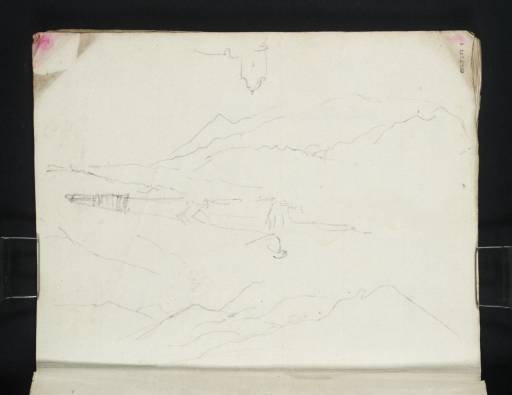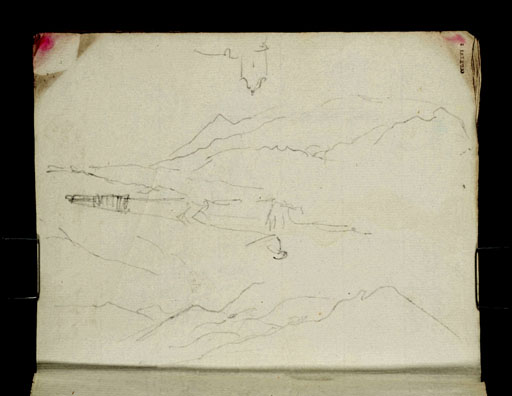J.M.W. Turner
>
1830-35 Annual tourist
>
Scotland 1831
>
Fort Augustus Sketchbook
>
Artwork
Joseph Mallord William Turner Ben Nevis from Neptune's Staircase, Caledonian Canal; and Cromwell's Tower, Inverness 1831
Image 1 of 2
Joseph Mallord William Turner,
Ben Nevis from Neptune's Staircase, Caledonian Canal; and Cromwell's Tower, Inverness
1831
Joseph Mallord William Turner 1775–1851
Folio 2 Recto:
Ben Nevis from Neptune’s Staircase, Caledonian Canal; and Cromwell’s Tower, Inverness 1831
D26967
Turner Bequest CCLXXVI 2
Turner Bequest CCLXXVI 2
Pencil on off-white laid writing paper, 150 x 184 mm irregular
Inscribed in red ink by John Ruskin ‘(2’ top left running vertically
Stamped in black ‘CCLXXVI 2’ top right running vertically
Inscribed in red ink by John Ruskin ‘(2’ top left running vertically
Stamped in black ‘CCLXXVI 2’ top right running vertically
Accepted by the nation as part of the Turner Bequest 1856
References
1909
A.J. Finberg, A Complete Inventory of the Drawings of the Turner Bequest, London 1909, vol.II, p.881, CCLXXVI 2, as ‘Mountains.’.
Turner first opened the Fort Augustus sketchbook as he left Fort William and began his journey north up the Caledonian Canal to Inverness. The two sketches on this page, drawn with the book turned so that the spine is at the bottom, were made from the southern end of the canal. At the centre of the page is a triangular shape that has been identified as a canal, with a lock gate represented by two chevrons. This is a view from Neptune’s Staircase, Thomas Telford’s staircase lock on the Caledonian Canal at Banavie near Fort William.
It would have taken some time for Turner’s boat to climb the staircase, giving the artist the opportunity to enjoy the spectacular view of Ben Nevis to the east. The mountain features in the background of the canal sketch, and again in the sketch beneath. However, it has been pointed out that the summit of Ben Nevis is not shown.1 Turner’s fading pencil line replicates how the mountain becomes obscured by cloud from about halfway up. The poor weather may explain why Turner did not dedicate more time and sketchbook space to Ben Nevis, though there are a few further views of the mountain from around this point on folios 3 and 4 (D26968, D26969).
At the top of the page, drawn with the sketchbook inverted, is a small sketch of a tower. This, Janet Carolan suggests, may be Cromwell’s Tower, an eighteenth-century clock tower in Inverness which is seen more clearly in a sketch in the Inverness sketchbook (Tate D27055; Turner Bequest CCLXXVII 6a). It may therefore have been the final sketch that Turner made in this book. Having reached the end of the sketchbook as he arrived in Inverness (folio 46 verso; D27043) the artist flipped back through the pages looking for empty space, filling a page previously left blank on folio 20 verso (D27001), and utilising the space at the top of the present page for this quick sketch.2
David Wallace-Hadrill and Janet Carolan, ‘Turner’s Journey from Oban to Inverness, 1831’, [circa 1991], Tate catalogue files, [folios 10–11].
Verso:
Blank
Thomas Ardill
April 2010
How to cite
Thomas Ardill, ‘Ben Nevis from Neptune’s Staircase, Caledonian Canal; and Cromwell’s Tower, Inverness 1831 by Joseph Mallord William Turner’, catalogue entry, April 2010, in David Blayney Brown (ed.), J.M.W. Turner: Sketchbooks, Drawings and Watercolours, Tate Research Publication, December 2012, https://www


